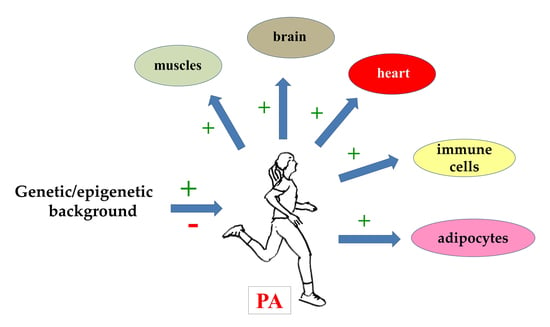Genetic and Epigenetic Modulation of Cell Functions by Physical Exercise
Abstract
:1. Introduction
2. Effects of Physical Exercise on Cardiovascular Disease, Inflammation, and Immunity
3. Impact of Physical Exercise on Body Mass Index and Lipid Metabolism
4. Impact of the Genetic Background on PA
5. Other PA Effects
6. Conclusions
Funding
Conflicts of Interest
References
- Tipton, C.M. The history of "Exercise Is Medicine" in ancient civilizations. Adv. Physiol. Educ. 2014, 38, 109–117. [Google Scholar] [CrossRef] [PubMed]
- Sallis, R.E. Exercise is medicine and physicians need to prescribe it! Br. J. Sports Med. 2009, 43, 3–4. [Google Scholar] [CrossRef] [PubMed] [Green Version]
- Berryman, J.W. Exercise is medicine: A historical perspective. Curr. Sports Med. Rep. 2010, 9, 195–201. [Google Scholar] [CrossRef] [PubMed] [Green Version]
- Russo, L. The Forgotten Revolution; Springer-Verlag: Berlin/Heidelberg, Germany, 2003; ISBN 3-540-20068-1. [Google Scholar]
- Booth, F.W.; Roberts, C.K.; Thyfault, J.P.; Ruegsegger, G.N.; Toedebusch, R.G. Role of Inactivity in Chronic Diseases: Evolutionary Insight and Pathophysiological Mechanisms. Physiol. Rev. 2017, 97, 1351–1402. [Google Scholar] [CrossRef] [PubMed]
- Diaz, K.M.; Shimbo, D. Physical activity and the prevention of hypertension. Curr. Hypertens. Rep. 2013, 15, 659–668. [Google Scholar] [CrossRef] [PubMed] [Green Version]
- Pescatello, L.S.; MacDonald, H.V.; Lamberti, L.; Johnson, B.T. Exercise for Hypertension: A Prescription Update Integrating Existing Recommendations with Emerging Research. Curr. Hypertens. Rep. 2015, 17, 87. [Google Scholar] [CrossRef] [PubMed] [Green Version]
- Schultz, M.G.; La Gerche, A.; Sharman, J.E. Blood Pressure Response to Exercise and Cardiovascular Disease. Curr. Hypertens. Rep. 2017, 19, 89. [Google Scholar] [CrossRef]
- Lachman, S.; Boekholdt, S.M.; Luben, R.N.; Sharp, S.J.; Brage, S.; Khaw, K.-T.; Peters, R.J.; Wareham, N.J. Impact of physical activity on the risk of cardiovascular disease in middle-aged and older adults: EPIC Norfolk prospective population study. Eur. J. Prev. Cardiol. 2018, 25, 200–208. [Google Scholar] [CrossRef]
- Pescatello, L.S.; Parducci, P.; Livingston, J.; Taylor, B.A. A Systematically Assembled Signature of Genes to be Deep-Sequenced for Their Associations with the Blood Pressure Response to Exercise. Genes 2019, 10, 295. [Google Scholar] [CrossRef] [Green Version]
- Willis, E.A.; Shearer, J.J.; Matthews, C.E.; Hofmann, J.N. Association of physical activity and sedentary time with blood cell counts: National Health and Nutrition Survey 2003-2006. PLoS ONE 2018, 13, e0204277. [Google Scholar] [CrossRef]
- Prins, F.M.; Said, M.A.; van de Vegte, Y.J.; Verweij, N.; Groot, H.E.; van der Harst, P. Genetically Determined Physical Activity and Its Association with Circulating Blood Cells. Genes 2019, 10, 908. [Google Scholar] [CrossRef] [PubMed] [Green Version]
- Schenk, A.; Koliamitra, C.; Bauer, C.J.; Schier, R.; Schweiger, M.R.; Bloch, W.; Zimmer, P. Impact of Acute Aerobic Exercise on Genome-Wide DNA-Methylation in Natural Killer Cells-A Pilot Study. Genes 2019, 10, 380. [Google Scholar] [CrossRef] [PubMed] [Green Version]
- Spiegelman, B.M.; Flier, J.S. Obesity and the regulation of energy balance. Cell 2001, 104, 531–543. [Google Scholar] [CrossRef] [Green Version]
- Blüher, M. Obesity: Global epidemiology and pathogenesis. Nat. Rev. Endocrinol. 2019, 15, 288–298. [Google Scholar] [CrossRef] [PubMed]
- Paoli, A.; Mancin, L.; Bianco, A.; Thomas, E.; Mota, J.F.; Piccini, F. Ketogenic Diet and Microbiota: Friends or Enemies? Genes 2019, 10, 534. [Google Scholar] [CrossRef] [PubMed] [Green Version]
- Chang, J.Y.; Park, J.H.; Park, S.E.; Shon, J.; Park, Y.J. The Fat Mass- and Obesity-Associated (FTO) Gene to Obesity: Lessons from Mouse Models. Obesity (Silver Spring) 2018, 26, 1674–1686. [Google Scholar] [CrossRef] [Green Version]
- Zhao, X.; Yang, Y.; Sun, B.-F.; Zhao, Y.-L.; Yang, Y.-G. FTO and Obesity: Mechanisms of Association. Curr. Diabetes Rep. 2014, 14, 486. [Google Scholar] [CrossRef]
- Liaw, Y.C.; Liaw, Y.P.; Lan, T.H. Physical Activity Might Reduce the Adverse Impacts of the FTO Gene Variant rs3751812 on the Body Mass Index of Adults in Taiwan. Genes 2019, 10, 354. [Google Scholar] [CrossRef] [Green Version]
- Nassef, Y.; Nfor, O.N.; Lee, K.J.; Chou, M.C.; Liaw, Y.P. Association between Aerobic Exercise and High-Density Lipoprotein Cholesterol Levels across Various Ranges of Body Mass Index and Waist-Hip Ratio and the Modulating Role of the Hepatic Lipase rs1800588 Variant. Genes 2019, 10, 440. [Google Scholar] [CrossRef] [Green Version]
- Del Coso, J.; Moreno, V.; Gutiérrez-Hellín, J.; Baltazar-Martins, G.; Ruíz-Moreno, C.; Aguilar-Navarro, M.; Lara, B.; Lucía, A. ACTN3 R577X Genotype and Exercise Phenotypes in Recreational Marathon Runners. Genes 2019, 10, 413. [Google Scholar] [CrossRef] [Green Version]
- Seto, J.T.; Lek, M.; Quinlan, K.G.R.; Houweling, P.J.; Zheng, X.F.; Garton, F.; MacArthur, D.G.; Raftery, J.M.; Garvey, S.M.; Hauser, M.A.; et al. Deficiency of a-actinin-3 is associated with increased susceptibility to contraction-induced damage and skeletal muscle remodeling. Hum. Mol. Genet. 2011, 20, 2914–2927. [Google Scholar] [CrossRef] [PubMed] [Green Version]
- Espinosa-Salinas, I.; de la Iglesia, R.; Colmenarejo, G.; Molina, S.; Reglero, G.; Martinez, J.A.; Loria-Kohen, V.; Ramirez de Molina, A. GCKR rs780094 Polymorphism as A Genetic Variant Involved in Physical Exercise. Genes 2019, 10, 570. [Google Scholar] [CrossRef] [PubMed] [Green Version]
- Grzybkowska, A.; Anczykowska, K.; Ratkowski, W.; Aschenbrenner, P.; Antosiewicz, J.; Bonisławska, I.; Żychowska, M. Changes in Serum Iron and Leukocyte mRNA Levels of Genes Involved in Iron Metabolism in Amateur Marathon Runners-Effect of the Running Pace. Genes 2019, 10, 460. [Google Scholar] [CrossRef] [PubMed] [Green Version]
- Di Liegro, C.M.; Schiera, G.; Proia, P.; Di Liegro, I. Physical Activity and Brain Health. Genes 2019, 10, 720. [Google Scholar] [CrossRef] [PubMed] [Green Version]

© 2019 by the author. Licensee MDPI, Basel, Switzerland. This article is an open access article distributed under the terms and conditions of the Creative Commons Attribution (CC BY) license (http://creativecommons.org/licenses/by/4.0/).
Share and Cite
Di Liegro, I. Genetic and Epigenetic Modulation of Cell Functions by Physical Exercise. Genes 2019, 10, 1043. https://doi.org/10.3390/genes10121043
Di Liegro I. Genetic and Epigenetic Modulation of Cell Functions by Physical Exercise. Genes. 2019; 10(12):1043. https://doi.org/10.3390/genes10121043
Chicago/Turabian StyleDi Liegro, Italia. 2019. "Genetic and Epigenetic Modulation of Cell Functions by Physical Exercise" Genes 10, no. 12: 1043. https://doi.org/10.3390/genes10121043





